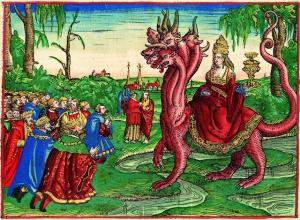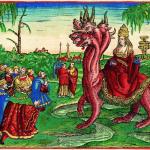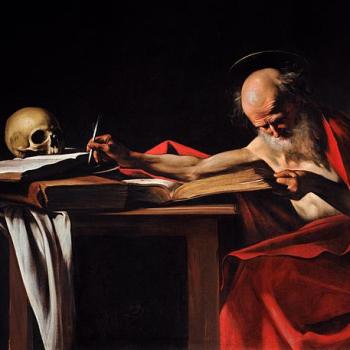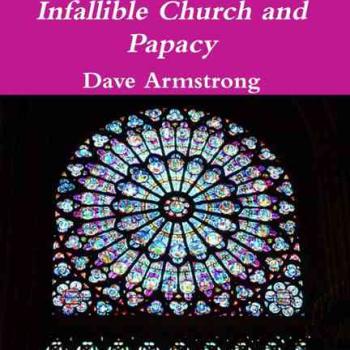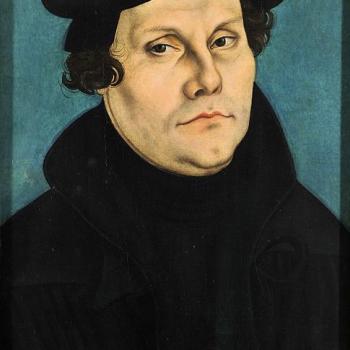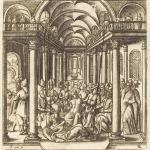Choosing to Pursue Truth; Received Tradition; Carnal Man & the Bible; Venial Sin; Newman No Innovator; Immaculate Conception; Mary’s In Partu Virginity; Catholic Prooftexts = Sola Scriptura?; Bible & Mary’s Perpetual Virginity
The late Steve Hays (1959-2020) was a Calvinist (and anti-Catholic) apologist, who was very active on his blog, called Triablogue (now continued by Jason Engwer). His 695-page self-published book, Catholicism — a collection of articles from his site — has graciously been made available for free. On 9 September 2006, Hays was quite — almost extraordinarily — charitable towards me. He wrote then:
I don’t think I’ve ever accused him of being a traitor or apostate or infidel. . . . I have nothing to say, one way or the other, regarding his state of grace. But his sincerity is unquestionable. I also don’t dislike him. . . . I don’t think there’s anything malicious about Armstrong—unlike some people who come to mind. In addition, I don’t think I’ve ever said he was unintelligent. For the record, it’s obvious that Armstrong has a quick, nimble mind.
Two-and-a-half years later, starting in April 2009 and up through December 2011 (in the following quotations) his opinion radically changed, and he claimed that I have “an evil character,” am “actually evil,” “ego-maniac, narcissist,” “idolater,” “self-idolater,” “hack who pretends to be a professional apologist,” given to “chicanery,” one who doesn’t “do any real research,” “a stalwart enemy of the faith . . . no better than [the atheists] Richard Dawkins or Christopher Hitchens,” with an intent to “destroy faith in God’s word,” “schizophrenic,” “emotionally unhinged,” one who “doesn’t trust in the merit of Christ alone for salvation,” “has no peace of mind,” “a bipolar solipsist,” “split-personality,” and a “bad” man. He wasn’t one to mince words! See more gory details.
I feel no need whatsoever to reciprocate these silly and sinful insults. I just wanted the record to be known. I’ve always maintained that Hays was a very intelligent man, but habitually a sophist in methodology; sincere and well-meaning, but tragically and systematically wrong and misguided regarding Catholicism. That’s what I’m addressing, not the state of his heart and soul (let alone his eternal destiny). It’s a theological discussion. This is one of many planned critiques of his book (see my reasons why I decided to do this). Rather than list them all here, interested readers are directed to the “Steve Hays” section of my Anti-Catholicism web page, where they will all be listed. My Bible citations are from the RSV. Steve’s words will be in blue.
*****
[Chapter 9: Magisterium]
Two paradigms
Roman Catholicism privileges the outlook of select individuals, viz. popes, bishops in ecumenical councils, Latin Fathers, church Doctors. [p. 514]
The Bible privileges the outlook of select individuals, viz. patriarchs, prophets, bishops at the Jerusalem council, apostles, Bible writers, evangelists like Paul and Peter.
There’s a problem with positing inhuman standards of certainty. An artificial standard that humans can’t attain. Everyone loses out when you set the bar that high. [p. 514]
There’s no problem with positing divine and biblical standards of certainty: a blessing or gift that humans can’t attain without God’s grace. Everyone wins out when God sets the bar that high, so that human beings can know spiritual and theological truth.
In addition, each of us is ultimately at the mercy of divine providence for what we believe. [p. 514]
Joshua 24:15 And if you be unwilling to serve the LORD, choose this day whom you will serve, whether the gods your fathers served in the region beyond the River, or the gods of the Amorites in whose land you dwell; but as for me and my house, we will serve the LORD.”
2 Timothy 4:3-4 For the time is coming when people will not endure sound teaching, but having itching ears they will accumulate for themselves teachers to suit their own likings, [4] and will turn away from listening to the truth and wander into myths.
It’s ultimately up to God whether your particular aptitude and experience guide you into truth. [p. 514]
Whether articles of faith must be certain depends on the kind of world we live in. Has God put us in a world where articles of faith must be certain? What if God put us in a world where articles of faith must only be likely? Can we know in advance of the fact which of those two worlds we inhabit? Isn’t that something we must discover? [p. 533]
1 Timothy 2:3-4 . . . God our Savior, [4] who desires all men to be saved and to come to the knowledge of the truth.
In the text [2 Thes 2:15] you initially cited, Paul points to his own teaching, and not some free-floating paradosis [tradition]. [p. 516]
1 Corinthians 15:3-7 For I delivered to you as of first importance what I also received, that Christ died for our sins in accordance with the scriptures, [4] that he was buried, that he was raised on the third day in accordance with the scriptures, [5] and that he appeared to Cephas [Peter], then to the twelve. [6] Then he appeared to more than five hundred brethren at one time, most of whom are still alive, though some have fallen asleep. [7] Then he appeared to James, then to all the apostles.
Catholics will make certain theological and ethical mistakes which some Protestants will avoid because Protestants don’t stop with the received answers but scrutinize them. [p. 517]
2 Timothy 3:6-8 . . . burdened with sins and swayed by various impulses, [7] who will listen to anybody and can never arrive at a knowledge of the truth. [8] As Jannes and Jambres opposed Moses, so these men also oppose the truth, men of corrupt mind and counterfeit faith;
Private interpretation
The Bible is propositional revelation. The meaning of Scripture can be understood by outright unbelievers. In that respect, understanding the Bible is no different than understanding a secular text. The role of the Holy Spirit is to engender receptivity to the message, not comprehension of the message. [p. 525]
1 Corinthians 1:18-21 For the word of the cross is folly to those who are perishing, but to us who are being saved it is the power of God. [19] For it is written, “I will destroy the wisdom of the wise, and the cleverness of the clever I will thwart.” [20] Where is the wise man? Where is the scribe? Where is the debater of this age? Has not God made foolish the wisdom of the world? [21] For since, in the wisdom of God, the world did not know God through wisdom, it pleased God through the folly of what we preach to save those who believe.
1 Corinthians 2:11-14, 16 For what person knows a man’s thoughts except the spirit of the man which is in him? So also no one comprehends the thoughts of God except the Spirit of God. [12] Now we have received not the spirit of the world, but the Spirit which is from God, that we might understand the gifts bestowed on us by God. [13] And we impart this in words not taught by human wisdom but taught by the Spirit, interpreting spiritual truths to those who possess the Spirit. [14] The unspiritual man does not receive the gifts of the Spirit of God, for they are folly to him, and he is not able to understand them because they are spiritually discerned. . . . [16] “For who has known the mind of the Lord so as to instruct him?” But we have the mind of Christ.
Romans 1:18, 21-22 For the wrath of God is revealed from heaven against all ungodliness and wickedness of men who by their wickedness suppress the truth….[21] for although they knew God they did not honor him as God or give thanks to him, but they became futile in their thinking and their senseless minds were darkened. [22] Claiming to be wise, they became fools, . . .
2 Peter 3:15-16 . . . So also our beloved brother Paul wrote to you according to the wisdom given him, [16] speaking of this as he does in all his letters. There are some things in them hard to understand, which the ignorant and unstable twist to their own destruction, as they do the other scriptures.
Catholic fideism
From a Protestant perspective, not all theological errors are culpable errors, much less damnably culpable. [p. 534]
From a Catholic perspective, not all theological errors are culpable errors, much less damnably culpable. This is precisely the [biblical and common sense] distinction we make between venial and mortal sin.
There’s no reason to think God will punish Christians who make innocent mistakes. [p. 534]
We totally agree. So does St. Paul:
1 Timothy 1:12-13 he judged me faithful by appointing me to his service, [13] though I formerly blasphemed and persecuted and insulted him; but I received mercy because I had acted ignorantly in unbelief,
John Henry Newman . . . invented the theory of development. [p. 534]
For the umpteenth time (repetition is a good teacher, except when lies like this are repeated), Cardinal Newman invented nothing. He developed one particularly fine-tuned and in-depth theory of development, completely from notions of development of doctrine that had been developing for over 1400 years: from St. Augustine and (especially) St. Vincent of Lerins, through Aquinas and others, to Mohler twenty years before Newman’s Essay came out in 1845.
Nowadays we see how the magisterium uses the theory of development to abrogate entrenched tradition and rationalize theological innovations. [p. 534]
That’s a lie, too. In fact, the Catholic Church roundly condemned evolution of dogma, which is very different from development of doctrine. They’re not the same at all. Nothing has changed in that regard. Hays is over his head, and true to form, he ignorantly and rather stupidly and irresponsibly conflated the two concepts (one orthodox and espoused by the Catholic Church and the other heretical and condemned by her). In a past reply I documented how the pope most opposed to modernism, Pope St. Pius X, gave a ringing endorsement of the orthodoxy of St. Cardinal Newman’s thinking, including development. As John Adams said, “facts are stubborn things.”
[Chapter 10: Marian Dogmas]
Marian mythology
What would count as evidence for the Immaculate Conception? What kind of evidence would even be probative? In the nature of the case, there could be no physical evidence for the Immaculate Conception. [p. 536]
As in my many defenses of it: 1) the meaning of kecharitomene in Luke 1:28 (“full of grace”), 2) what it means to be full of grace, according to Paul (without sin), 3) the fittingness (yes, that is a biblical concept) of Mary being without sin, original and actual, as the Mother of God, 4) analogies to other holy figures made holy by God in the womb in accordance with their high calling, 5) the biblical and patristic typology of the New or Second Eve, who reversed the “no” of Eve with a “yes” to God, 6) #3 and #5 lead logically to a special miraculous act of grace by God at the very beginning of Mary’s existence; i.e., at her conception, 7) pondering why an angel would “hail” Mary, 8) the possibility and actuality of other sinless creatures in the Bible (analogy), 9) The NT analogy of Mary as the new ark of the covenant.
In what respect, if at all, would the Immaculate Conception even be detectable to Mary or her parents? [p. 536]
Primarily by special revelation, which is precisely what Mary received. God sent the angel Gabriel to her. Secondly, as she went through life, due to being preserved from original sin, Mary wouldn’t be burdened by the concupiscence (tendency or desire to sin) that the rest of us labor under, and she would come to be aware of that by talking to others who did have to deal with it. Her lack of actual sin would also set her apart from everyone around her except for Jesus.
Assuming (ex hypothesi) that Mary was sinless, what evidence could there be that she was sinless from the moment of her conception, rather than at some later stage in utero, or as a newborn baby, or one-year-old? In other words, if God intervened to exempt her from the stain of original sin, how would Mary or her parents know when that happened? Even in principle, how could there be any evidence for the timing of God’s intervention? [p. 536]
Good and interesting question. I’m just speculating (hopefully piously!), but I think that it would be an extrapolation from knowledge of Old Testament saints like Jeremiah being chosen and set aside from the womb and pondering that such a special grace may as well be from the very beginning of her preborn life or conception, according to what was known (biologically) of such things in those days. They knew that a person began in the womb (as a result of intercourse), formed by God because that is biblical (in the Psalms and elsewhere). They didn’t know that it was so early that it had no detectable signs. They didn’t know about DNA, etc.
In other words, Mary would have had to think about it and speculate, just as Duns Scotus later did. Whether she actually worked all that out, we simply don’t know. But in any event, she didn’t have to for it to be true. It’s interesting to think about, but has absolutely no bearing on whether the doctrine is true or not. If I don’t know how my stomach and intestines and colon and kidneys and liver digest and filter food, it doesn’t follow that they aren’t doing so in my body. They are what they are and they do what they do, regardless of my state of knowledge about their workings.
For that matter, surely the church fathers had a different understanding of conception and the moment of conception, than we do, thanks to modern gynecology and related disciplines. [p. 536]
Yes they did, because of the primitive state of biology and reproductive biology. So for centuries they held to Mary being actually sinless, but not freed from original sin. Some may perhaps have thought (I don’t recall examples) that her sanctification began in the womb, analogous to Jeremiah, John the Baptist, etc. Freedom from actual sin is the kernel of the more developed doctrine of freedom from original sin (taking it back to her conception rather than her birth), which was first probably fully understood by Blessed Duns Scotus (c. 1265-1308).
Since Hays had no understanding of development of doctrine at all, and rejected it in his ignorance, all of this would be gibberish to him. He thought that every doctrine emerged from the pages of the Bible whole and entire, and incapable of any further development. Hence he stated that Chalcedonian Christology was lower than that of the Bible.
So what does the traditional dogma even mean? [p. 536]
It means that the kernel (actual sinlessness based on fittingness as the Mother of God) was there from the beginning: indeed in Luke 1:28 and that it was developed over many centuries as the Immaculate Conception, to be declared as a dogma at the highest level in 1854. Catholics actually believe that pious Christians can ponder spiritual things, even for many centuries, and come to deeper understandings of them, with the help of the Holy Spirit.
Is it not far more likely that this belief evolved through multiple stages of theological speculation? [p. 536]
Yes, it went through a long process, but it consistently developed rather than evolved (like a dinosaur to a mammal or suchlike) into something totally other than what it was from the beginning.
Consider the virginity in partu. What would even count as evidence for that claim? Would there be physical evidence? [p. 536]
Obviously the evidence was an intact hymen after the birth of Jesus, which is what the ancients meant by “virginity “during” birth, and traditionally the physical meaning of virginity, as opposed to the lack of engagement in sexual intercourse, as today. And the Blessed Virgin Mary would know this and know what she went through (or didn’t go through) during the miraculous birth and could tell Luke this information. It’s not difficult to figure these things out (whether one believes them or not). This is the evidence, and in this case it’s empirical / physical.
Notice two clashing Catholic paradigms. On the one hand is the old, pre-Newmanesque, Counter-Reformation (a la Bellarmine) paradigm, where you attempt to prooftext Catholic dogma from Scripture. [p. 537]
Funny, I’ve been doing that for 32 years. It’s what I am probably most known for in my apologetics.
Yet so many Catholics fight tooth-n-nail for these traditional prooftexts, as if they really believe in sola scripture [sic], which makes them cling for dear life some Biblical warrant for each and every Catholic dogma. [p. 537]
Sola Scriptura is the belief that Scripture is the final authority and standard and only infallible one for doctrine and theology. It’s the Protestant rule of faith. Catholics producing biblical proof for Catholic doctrines is simply systematic theology: done by all sorts of Christians. It’s apples and oranges, or more like apples and squash. The two have nothing to do with each other. So why did Hays make this silly comparison?
The schizophrenia is something to behold. Perhaps psychotropic medication will relieve the unbearable tension. [p. 537]
Since Hays’ equation doesn’t fly in the first place, the melodramatic and sophistical potshot based on the wrongly imagined contradiction flowing from the non-comparison simply makes Hays look ridiculous. It’s a familiar trait. Some old saying about “don’t spit in the wind . . . ” comes to mind.
Notice that defending Catholicism is just as complicated as defending Protestantism. [p. 537]
Yeah? Having defended both, I find Catholicism much easier to defend, because there are a great many more applicable biblical evidences to bring to bear. Catholicism takes all of the Bible into account. Protestantism (i.e., in its many guises) tends to greatly emphasize merely a few prooftexts that are employed over and over, while many other relevant passages are ignored.
Is the PVM a big deal?
The onus is not on Protestants to provide evidence to the contrary, but on Catholics to provide sufficient evidence. It’s not incumbent on me to disprove something for which there’s no good evidence. If you tell me there’s a genie in the bottle, the burden of proof is not on me to prove you wrong. [p. 540]
Plenty of biblical evidence exists for the perpetual virginity of Mary. I recently wrote a succinct nine-point summary of it (I won’t bother indenting so much material):
1) In comparing Matthew 27:56, Mark 15:40, and John 19:25, we find that James and Joseph (mentioned in Matthew 13:55 with Simon and Jude as Jesus’ “brothers”) are the sons of Mary, wife of Clopas. This other Mary (Mt 27:61; 28:1) is called the Blessed Virgin Mary’s adelphe in John 19:25. Assuming that there are not two women named “Mary” in one family, this usage apparently means “cousin” or more distant relative. Matthew 13:55-56 and Mark 6:3 mention Simon, Jude and “sisters” along with James and Joseph, calling all adelphoi. The most plausible interpretation of all this related data is a use of adelphos as “cousins” (or possibly, step-brothers) rather than “siblings.” We know for sure, from the above information, that James and Joseph were not Jesus’ siblings. . . .
2) Jude is called the Lord’s “brother” in Matthew 13:55 and Mark 6:3. If this is the same Jude who wrote the epistle bearing that name (as many think), he calls himself “a servant of Jesus Christ and brother of James” (Jude 1:1). Now, suppose for a moment that he was Jesus’ blood brother. In that case, he refrains from referring to himself as the Lord’s own sibling (while we are told that such a phraseology occurs several times in the New Testament, referring to a sibling relationship) and chooses instead to identify himself as James‘ brother. This is far too strange and implausible to believe. Moreover, James also refrains from calling himself Jesus’ brother, in his epistle (James 1:1: “servant of God and of the Lord Jesus Christ”): even though St. Paul calls him “the Lord’s brother” (Gal 1:19).
3) Commenter Alex Lielbardis brought up this further argument:
Mark 6:4 And Jesus said to them, “A prophet is not without honor, except in his own country, and among his own kin [(συγγενής, ές / suggenes)], and in his own house.” (cf. Jn 7:5: “For even his brothers did not believe in him.”)
He added:
The plural Greek word used refers to kinsfolk, relatives, or fellow countrymen. This same word is used by Luke in his account of the Annunciation which in the singular form specifically means a cousin: “And behold, your kinswoman [συγγενίς / syngenis] Elizabeth in her old age has also conceived a son; and this is the sixth month with her who was called barren” (Luke 1:36). Thus, Jesus apparently replies with his cousins (relatives or kin) in mind, in response to what was said by those who were offended at him.
The context of this incident was His preaching in His hometown of Nazareth. Both Mark (6:3) and the parallel text in Matthew (13:55-56), in the immediate context mention four “brothers” of Jesus” and also, unnamed “sisters.” Jesus was catching flak from these relatives in His hometown. Both Matthew and Mark record Jesus as saying in response that a “prophet” is not honored “in his own house.”
4) Luke 2:41-51 describes Mary and Joseph taking Jesus to the temple at the age of twelve, for the required observance of Passover. Everyone agrees that He was the first child of Mary, so if there were up to five or more siblings, as some maintain (or even one), why is there no hint of them at all in this account? I recently wrote in-depth about this. If Jesus had brothers or sisters and He was the oldest, then He certainly would have had siblings at 12 years old, when His parents took Him to Jerusalem for the Passover (Luke 2:41-50) — particularly since Mary was estimated to have been around 16 at His birth, which would make her still only around 28 at this time. We’re to believe that it makes sense that she bore her first child at 16 and then had no more from 16-28, and then more than four after that? That’s not very plausible at all.
5) The Blessed Virgin Mary is committed to the care of the Apostle John by Jesus from the Cross (John 19:26-27). Jesus certainly wouldn’t have done this if He had brothers (all of whom would have been younger than He was).
6) Nowhere does the New Testament state that any of Jesus’ “brothers” (adelphoi) are the children of Jesus’ mother Mary, even when they are referenced together (cf. Mark 3:31 ff.; 6:3 ff.; John 2:12; Acts 1:14). So for example, in Mark 6:3 and Matthew 13:55. Jesus is called “the son of Mary” and “the carpenter’s son” and only He is referred to in this way. The others (four “brothers” named in each passage) are not. It happens again in the book of Acts:
Acts 1:14 All these with one accord devoted themselves to prayer, together with the women and Mary the mother of Jesus, and with his brothers
See how a distinction is made between Mary as the mother of Jesus and “his brothers,” who are not called Mary’s sons? Nor is she called their mother. These verses do not read in a “siblings” way. Svendsen writes: “We further read that Jesus has ‘brothers’ and ‘sisters’ (in texts that place them with his ‘mother’), from which we infer that these are biological siblings” (p. 58), but he doesn’t delve deep enough into the texts, to notice the important distinctions made, as I have above. It looks like he simply sees only what he wants to see.
7) In the New Testament, none of these “brothers” are ever called Joseph’s children, anywhere, either.
8) Much has been written about the use of adelphos in the NT. Its range of use is almost precisely like how it is used in the works of the first century Jewish historian Josephus (as we would expect, since he was a fellow Israelite and lived in the same period). In Antiquities, Book XVIII, ch. 4, sec. 6, Josephus refers to “Philip, Herod’s brother” (likely using adelphos there). In Wars of the Jews, Book II, ch. 6, sec. 1, he refers to “Archelaus’s brother Philip.” But we know that they were not siblings (sons of the same mother and father). In Wars of the Jews, Book II, ch. 7, sec. 4, Josephus mentions “Alexander, who was the brother of Archelaus, . . . This Alexander was the son of Herod the king . . .” Again, he likely uses adelphos, but is not referring to literal siblings, since we know that this Alexander’s mother was Mariamne. Wikipedia (“Philip the Tetrarch”) informs us that Philip was “son of Herod the Great and his fifth wife, Cleopatra of Jerusalem, . . . half-brother of Herod Antipas and Herod Archelaus.” The mother of the latter two men was Malthace.
Now I shall compare Josephus’ use of terms for relatives (excluding the straightforward terms mother, father, son, daughter), over against that of the NT. Adelphos appears in the NT 346 times and syngeneís [“cousin”] only appears twelve times. Anepsios [“cousin”] appears once (Col 4:10). Here is the breakdown of NT terms for relatives (in the RSV):
brethren 191
brother(s) 159
sister 24
mother-in-law 5
daughter-in-law 3
father-in-law 1
cousin 1
uncle / aunt / nephew / niece 0
son-in-law 0
kin 1
Out of these 385 instances, 374 of them (or 97%) are either brother, brethren, or sister. The one appearance of cousin is 0.26% of the whole. Likewise, in Josephus (Antiquities and Wars of the Jews), out of 1024 terms for relative, 867 (85%) are brother, brethren, or sister. The thirteen appearances of cousin are 1.3% of the whole: remarkably similar usage to the NT, which also uses adelphos for non-siblings.
9) The same strikingly similar usage is found in the Septuagint (LXX): the Greek translation of the Old Testament. Adelphos appears 649 times (99%), syngeneís only appears five times (0.76%), and anepsios appears once (0.15%).
See my related paper, Josephus & “Brothers of Jesus” Redux (vs. Lucas Banzoli) [2-18-23], and many other treatments of the general topic on my Blessed Virgin Mary web page.
Did Hays (at least in this immediate section) deal with any of this considerable amount of biblical argumentation? No, he didn’t (what an incredible surprise). He may not have even been aware of any or most of it.
I will not give the dignity of a reply to blasphemous comments about Mary that Hays made on pages 540 and 541.
***
Practical Matters: Perhaps some of my 4,300+ free online articles (the most comprehensive “one-stop” Catholic apologetics site) or fifty-one books have helped you (by God’s grace) to decide to become Catholic or to return to the Church, or better understand some doctrines and why we believe them.
Or you may believe my work is worthy to support for the purpose of apologetics and evangelism in general. If so, please seriously consider a much-needed financial contribution. I’m always in need of more funds: especially monthly support. “The laborer is worthy of his wages” (1 Tim 5:18, NKJV). 1 December 2021 was my 20th anniversary as a full-time Catholic apologist, and February 2022 marked the 25th anniversary of my blog.
PayPal donations are the easiest: just send to my email address: apologistdave@gmail.com. You’ll see the term “Catholic Used Book Service”, which is my old side-business. To learn about the different methods of contributing, including 100% tax deduction, etc., see my page: About Catholic Apologist Dave Armstrong / Donation Information. Thanks a million from the bottom of my heart!
***
Photo credit: The Whore of Babylon (workshop of Lucas Cranach): colorized illustration from Martin Luther’s 1534 translation of the Bible [public domain / Wikimedia Commons]
***
Summary: The late Steve Hays was a Calvinist and anti-Catholic writer and apologist. This is one of my many critiques of Hays’ “Catholicism”: a 695-page self-published volume.


